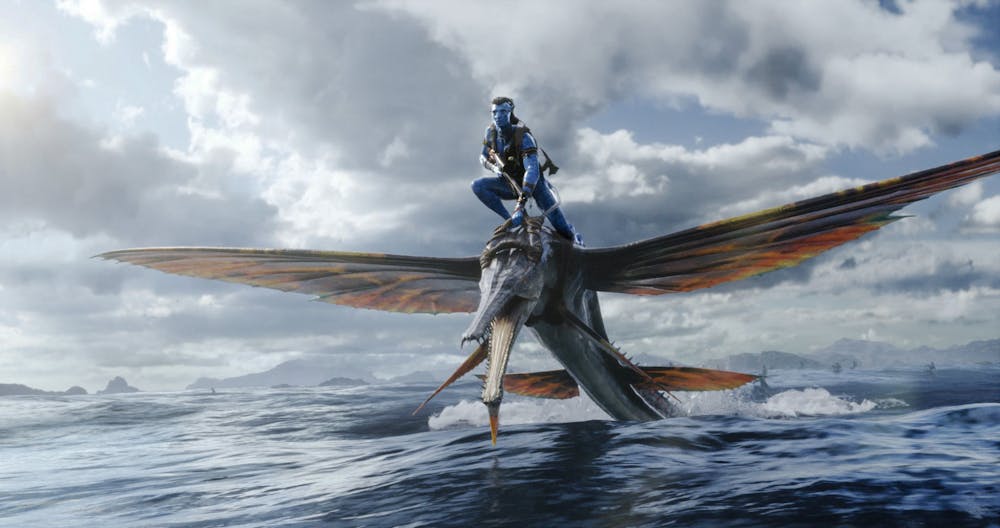Thirteen years after the release of “Avatar” in 2009, writer, director and producer James Cameron has once again made himself a household name with his new sci-fi epic “Avatar: The Way of Water.” Cameron’s return to the fictional world of Pandora is a visual treat that takes viewers far beyond the boundaries of the original film. And although the film’s plot is relatively bland, its hyperrealistic visual effects and imaginative world-building make “The Way of Water” a far more vibrant experience than its predecessor. What the film lacks in plot, it makes up for in technical ability and spectacle.
Set in the 22nd century, more than a decade after the original film's events, “The Way of Water” builds on the story of Jake Sully (Sam Worthington), a former Marine turned Na’vi, the dominant inhabitants of Pandora. The film follows Sully and his wife Neytiri (Zoe Saldaña) as they try to protect their family from the ongoing threat of human invaders, hunters and colonizers led by Miles Quaritch (Stephen Lang), the villain of the original 2009 picture. The movie is primarily set in a tropical-inspired area inhabited by the Metkayina, a Na’vi ocean reef clan inspired by the Māori, the Indigenous Polynesian people of New Zealand.
From the breathtaking underwater scenes to the fictionalized sea creatures Cameron and his team create, “Avatar: The Way of Water” continues to build out the world of the first film. Despite a runtime of over three hours, these subaquatic moments and the film’s ample amount of action make the film feel far shorter than it really is. Given Cameron’s history with films like “Titanic” (1997) and “The Abyss” (1989), as well as his experience with deep sea exploration, the new movie also makes a point to flex the director’s well-established talents.
Despite the film’s visual effects masterfully blurring the line between reality and fiction, its plot remains lackluster — no more interesting than the preceding film’s relatively unoriginal plot about colonizers in space. The film centers around Sully and Neytiri trying to protect their family and generally lacks complexity. Luckily, in the case of “The Way of Water,” prioritizing spectacle over narrative works well, allowing viewers to sit back and enjoy the film’s technical achievements and embrace the world of Pandora.
Narrative flaws and groundbreaking visuals aside, the cast does a phenomenal job, particularly Saldaña and Sigourney Weaver. Weaver returns as a new character after playing botanist Grace Augustine in the first film. In “The Way of Water,” she plays Kiri, the 14 year old adoptive daughter of Neytiri and Sully. Being 73 years old in real life, Weaver is able to explore an entirely new side of acting through the role — and she does so spectacularly.
Many scenes in “The Way of Water” are created via motion capture. Cameron and the film’s crew developed a new method of motion capture that allowed the actors to shoot their scenes underwater, making the action look much more natural. This unique underwater motion capture technology was the central cause for the film taking thirteen years to complete. Cameron and producer Jon Landau were not simply reusing old technology to make a new film, but instead investing in developing new technologies and means of filmmaking.
While some viewers might preach that this film must be seen in theaters to be properly enjoyed, that is only partially true. In an interview with National Public Radio, James Cameron said that “if you watch ‘Way of Water’ at home on a reasonably large flat screen TV with a decent sound system … you're going to have a good experience.”
“Avatar: The Way of Water” may not be the most narratively complex film, but James Cameron’s directing and the movie’s visuals add up to a highly entertaining story that surpasses the 2009 film. Cameron’s film is, in many ways, the stereotypical blockbuster — it sacrifices story for spectacle. But the film’s visuals play into its audience’s childlike sense of wonder, allowing Cameron to prove once again that he is one of the best filmmakers in Hollywood.





